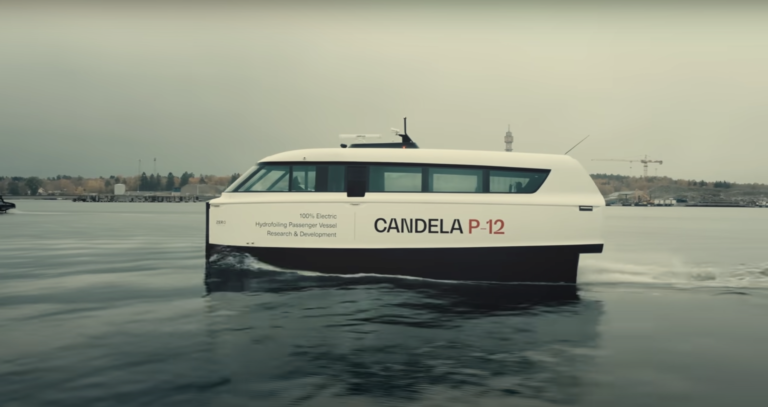Swedish tech company Candela Technology has completed test flights of its electric hydrofoiling passenger vessel, the Candela P-12, which the company states is “the world’s first electric flying passenger ship”. The vessel is now progressing into serial production at Candela’s Rotebro factory.
First announced in concept form in June 2022, the P-12 employs computer-guided hydrofoils to elevate its hull above water friction. When foilborne at speeds over 18kts, the Candela P-12 consumes 80% less energy than traditional high-speed vessels. This solution is intended to address the primary challenges that have hindered the widespread adoption of electric, fast vessels to date – limited range and slow speeds due to the excessive energy consumption of conventional hulls.
During its first ‘flights’, the Candela P-12 achieved a top speed of 30kts. With a range of up to 50 nautical miles, it is the first electric ship with the practical endurance to cover most coastal transport needs, Candela says. Tests also confirmed the minimal wake, which opens up exemptions from speed limits as the P-12 will neither erode coastlines nor damage docks and moored ships, even at full speed.
Erik Eklund, director for commercial vessels at Candela, commented, “With the P-12, we’re not just offering a faster, more comfortable electric alternative to fossil fuel-powered vessels. We enable operators to make the switch to sustainable vessels that are cost-effective and profitable, a crucial step toward clean oceans and lakes.”
Once in service, operators can expect reduced ‘fuel’ costs by up to 90% compared to diesel vessels. The C-POD motors require minimal servicing, and the vessel is designed for single-crew operation, which further reduces costs. In total, the P-12 is expected to cut costs per passenger kilometer by up to 50%, achieving a similar operational per-passenger economy as a hybrid electric bus.
To improve the passenger boarding experience Candela has created an extendable, automatic bow ramp, adjustable for docking at varying quay heights from 0.3m to 1.8m. This versatility enables the P-12 to serve a range of routes globally without the need for dock alterations. According to the company, each stop’s turnaround time is under two minutes, as a result of the C-POD motors’ thrust vectoring for maneuvering – even enabling the vessel to move sideways when required. Once flying, the digital flight control system compensates for waves, side wind and current by adjusting the hydrofoils’ angle of attack 100 times per second, providing a smooth ride free from sea sickness-inducing pitching and slamming. This system has been developed by Candela’s engineers since 2016 and fine-tuned in the company’s leisure vessels, the C-7 and C-8.
The P-12 is available in three variants – the P-12 Shuttle, P-12 Business and P-12 Voyager. Priced at €1.7m (US$1.85m), the 30-seat shuttle variant of the P-12 matches the cost of similar-sized ICE vessels and is priced lower than similarly sized EVs. This is possible due to its hydrofoil efficiency, which enables an extended range from a modest 252kWh battery. Combined with a streamlined serial production, this leads to industry-low overall unit costs. Allocated space for bicycles (along with strollers and wheelchairs) is intended to encourage the integration of cycling with public transportation.
The business version features a premium interior with seating for 12 to 20 passengers (and plenty of luggage), and the adaptable Voyager version offers customers flexibility in interior design, catering to both private leisure and commercial clients.
“The P-12 is a platform that will cater to a vast range of clients. Whether it’s public transport fleets, VIP services or private customers, it will revolutionize how we travel on water,” said Gustav Hasselskog, CEO of Candela.
The Candela P-12 Shuttle is set to join Stockholm’s public transportation network in 2024 in a trial, reducing the Ekerö suburb-city center commute from 55 to 25 minutes, surpassing cars, buses and current diesel ferries in speed. This is possible by obtaining an exemption from the city center’s speed limits, thanks to the vessel’s minimal wake.
In Stockholm, as in many waterfront cities, waterborne traffic has been dwindling as buses and cars provide quicker and more affordable transportation. The P-12 aims to reverse this trend.
Hasselskog says, “Today, in many cities, congested roads are common while waterways – humanity’s oldest transport infrastructure – remain underutilized for rapid commuting. The P-12 will let you use these waterways as green highways, enabling fast intra-city connections. Often, the quickest route is by water.”
Read more of the latest ferries and cruises updates from the electric and hybrid marine technology, here.



